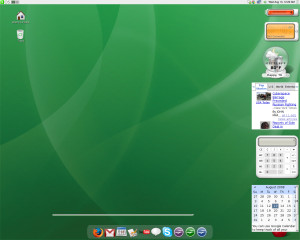Author: Jeremy LaCroix
I first heard of gOS when it was chosen to power the $199 Wal-Mart gPC. The third iteration of the OS, gOS 3.0 “Gadgets” Beta, was released last week. It’s a great Web-focused desktop, but it doesn’t offer much to experienced or current Ubuntu users.
I downloaded the ISO image of gOS 3.0, burned it to a CD, and installed it on one of my test systems. I used a basic PC with a 1.7GHz AMD Duron processor and 512MB of RAM, to see how well gOS fared on an unimpressive machine.
Like many other Ubuntu variants, gOS uses the same type of live CD and installation routine as the distribution it’s built on. If you’ve installed Ubuntu before, you can expect the same prompts and the same amount of installation time, which is still less than 20 minutes even on an older machine. All of my hardware was detected and I ran into no problems getting it installed. If you’re not ready to make the commitment of installation, the live CD itself is very functional. With Google Docs, you can save your documents online, so you’ll need little disk space on your PC to be productive, and in most cases no configuration needs to be done to get online.
When you first log in to gOS 3.0, you’ll first realize that this distribution is green — very green. Almost everything in the theme and icons have at least some green color, and the look and feel of this OS is actually pleasing and consistent. The top panel serves most of the functionality, such as showing running applications, a desktop pager, an applications menu and a clock. Along the bottom edge of the screen is a dock containing links to popular online services, such as Gmail, Google Calendar, OpenOffice.org, and Google Docs. On the right side of the screen you’ll find several Google Gadgets already placed for you, such as a news reader and weather applet. Even the applications menu has been simplified. The theme itself places the close, maximize, and minimize functions on the left side of the window borders rather than on the right, which may confuse some at first.
Under the hood, several things have changed. gOS 3.0 is now based on Ubuntu 8.04.1 LTS. While gOS debuted with the Enlightenment 17 Window Manager as the default desktop, this new release sports GNOME 2.22.2. The basic applications are mostly the same as those in Ubuntu, such as Firefox 3.0 for Web browsing, OpenOffice.org 2.4.1 for office tasks, and Pidgin 2.4.1 for instant messaging. Missing, however, is Rhythmbox or any application to manage your audio playlists.
gOS differs from Ubuntu in terms of packaged applications mainly in the inclusion of Skype and Google Gadgets. Google Gadgets itself is the highlight of this release, which allows you to add “gadgets” to your desktop to provide specific functions, such as showing current weather information or Google News. A ton of gadgets are included here, and more can be added from the Google Gadgets interface.
Also included by default in this release is Wine, a Linux tool that helps you to run Windows applications. While Wine doesn’t support every Windows app, the effort to include it to help ease the transition for new users is admirable.
On the downside
While gOS is a great desktop for Internet cafe computers or the casual Internet user, there isn’t much reason to use it over Ubuntu itself, as with a little work you could duplicate the look and installed applications of gOS yourself. Even the repositories used in this distribution are exactly the same as those of Ubuntu. However, this distro wasn’t intended to appeal to professional Linux users, and new users will probably appreciate the easy access to some of the most commonly used Web 2.0 services. In addition, while the bottom dock is nice, I was unable to find a way to customize it or add new items to it, and the YouTube link did not function for me in my tests.
Performance-wise, gOS 3.0 is just about as fast as a standard Ubuntu 8.04 install, and ran for me without a hitch. However, on an older system, you may notice a bit of slowdown. Previously, gOS was hyped as being able to run well on lower-end machines, yet due to the inclusion of the GNOME desktop in the latest version, I’m somewhat cautious as to how well it would run on a lower-powered netbook or bargain PC.
If you’re looking for a beginner-level GNU/Linux distribution, or one that is heavily focused on Internet services, gOS 3.0 is for you. Otherwise, this distro won’t do much to steal you away from your current one, especially since this is mostly a rebranded and rethemed Ubuntu 8.04 with Google Gadgets and services thrown in. Still, as a simplistic Web desktop with Google Gadgets installed by default, gOS 3.0 may be worth a look.
You’ve read the review — now see Robin Miller’s video tour of gOS Gadgets 3.0 beta!
Categories:
- gOS
- Reviews
- Linux
- Desktop Software



